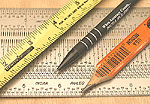This is a Veteran Owned site

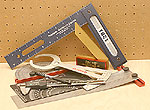 |
Using these (and more) precision tools allow me to do better woodworking. Having them in the shop does not make anyone, or me foolish. Click image to enlarge |
Accuracy In Woodworking
Accuracy In Woodworking
Is precision with wood foolish?
Text & Photos by Tom Hintz
Within woodworking are those who enjoy using evolving technology of hyper-accurate measuring devices while others embrace more traditional techniques and tools. While there is plenty of room for both, everyone must realize that what works for them may not be right for someone else. Unfortunately, this is not always the case.
A recent forum exchange that began as a simple question about measuring stock thickness evolved into a multi-page rush of replies. Those answers ranged from well-balanced suggestions (the majority) to others that flatly denied the usefulness of high resolution measuring technology. My favorite is a fellow on a forum that calls anything with a dial indicator "overkill". for him it may be but for those who want to use dial indicators, they are just fine, legal and they should not be subjected to rants by those who want to do it differently.
One responder even reminded us that we are dealing with woodworking projects and not creating parts for NASA. (National Aeronautics and Space Administration) I suspect many woodworkers would be surprised at how close to NASA tolerances a good-fitting dovetail or mortise and tenon joint actually is.
Traditional Tools and Methods
I admire those who have mastered the use of hand tools and create beautiful joinery and projects. There are woodworkers who with nothing more than a tape measure and square, produce beautiful furniture with close-fitting parts. The problem is, envying those capabilities does not make them part of my current skill set. In the future, I would like to try learning these skills, a sentiment often expressed by other woodworkers who currently enjoy the use of machines and high resolution measuring tools.
A frequent point cited by potential hand-tool users is the demands of careers and busy lifestyles severely limit the time available for woodworking but not the passion. Most of these woodworkers look forward to more settled times that would allow them to pursue the use of more traditional skills and tools.
We have to keep in mind that many woodworkers are perfectly happy using modern technology and have no desire to use hand tools or techniques. That is their choice and there is nothing wrong with that.
Evolving Technology
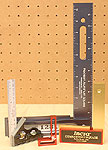 |
Squares are some of the most-used tools in the woodshop and ones we depend on being accurate to be sure our projects are as well. Click image to enlarge |
Woodworkers have always followed the advancements in technology. While handsaws are capable of virtually all rip and crosscut needs, high end table saws and fence systems capable of high degrees of accuracy remain prized tools in home wood shops. Angle cuts could be made with an age-old miter box but high-tech miter gauges are among the best selling woodworking accessories today.
Certainly, hand-cut dovetails are possible and remain a favorite of a segment of the woodworking community. However, the remarkable popularity of the high-tech and super accurate Leigh D4 dovetail jig, just one of several very popular high-end jigs available, clearly demonstrates that a very large portion of the woodworking community enjoys using them.
The point is, there is nothing new about woodworkers seeking out and using the latest technology available.
Stability and Accuracy
Some feel the natural tendency off wood to expand and contract in response to temperature and humidity changes lessens the need for accuracy. Others feel those same characteristics make it even more important to cut, shape and form the wood accurately.
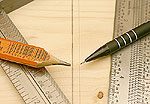 |
Even the pencils we draw our layout lines have options for accuracy today. Click image to enlarge |
While wood is admittedly an inconsistent medium, the total amount of expansion or contraction can be related to physical size. If both sides of a cabinet are exactly the same length, width and thickness, expansion and contraction will affect both more equally. This helps the project stay square and reduces the stress that movement puts on interconnected parts and joints.
Joinery can be especially dependent on the dimensional accuracy of the individual parts. Whether we use a dado, mortise and tenon or dovetail joint, if the pieces are all the same thickness, the joints themselves are more consistent as are the pressures they experience during the expansion/contraction cycles.
Most often joints are cut in multiples with one machine setting is used to prepare a number of pieces. If those pieces vary in thickness, the resulting joints can vary significantly in fit. Some might be a little loose while others can be tighter than needed. When the wood expands or contracts, that variance can produce splits or other failures that are less likely to occur if the wood was consistent in thickness, width and length. The consistency that accuracy insures when preparing the pieces can be crucial.
Machine Setup
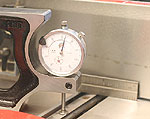 |
Setting machines up correctly is critical to how they perform, safety when using them and how long they last. Aside from those points, setup isn't all that important. Click image to enlarge |
One of the stranger arguments I have heard is that the woodworkers of old used nothing more than comparative cuts to set up machines, proving that today’s high-tech instruments are unnecessary. That would be true if we still used the wooden-bed machines and erratic blades from back then. The power and accuracy of modern woodworking equipment makes precise setups not only a performance issue but one of safety as well.
I know there are those who set machines up with sticks and screws, and apparently do a good job of it. Again, I admire that kind of ingenuity and skill. However, there are lots of woodworkers, myself included, that are more proficient – and comfortable – with a good setup tool that quantifies deviations down to 0.001” and less.
One thing about some of the stick and screw guys. There are a few who loudly dismiss the legitimacy of a dial indicator. Yet, they claim to know that their stick and screw adjustment is within 0.001" or 0.002". Either they are simply guessing at that accuracy or are measuring it with a dial indicator. I just choose to use the dial indicator from the start and be done with it.
Another thing I personally like about the precision setup tools is being able to hit my blade or bit height exactly, the first time and then being able to go back to that same exact setting later if need be. I can get very close with several tools but with a good dial indicator zero error is easy.
Right and Wrong
Because woodworking is such an individual pursuit, woodworkers who embrace high accuracy and those who don't can both be right. The important thing to remember is that they are right for themselves and what they are doing. Both can produce outstanding work and both probably will have failures along the way.
The easiest way to be totally wrong is to impose your beliefs on someone else. There is plenty of room for reasoned exchanges of ideas but when that degenerates to even veiled insinuations that any one way of thinking is wrong, everyone suffers.
If using a tape measure and yardstick is all you need to build great projects, I envy you. If digital calipers and other high-tech measuring devices make your woodworking better or more enjoyable, have at it. Both of you are right and have every right to pursue woodworking in the way that makes you happy.
As always, the true common ground in woodworking is producing good work and doing it safely. Whether you use a micrometer or yardstick to produce good work should be of little consequence to anyone else.
All written, photographic and drawn materials are property of and copyright by NewWoodworker.com LLC 2000-2019. Materials may not be used in any way without the written permission of the owner.

